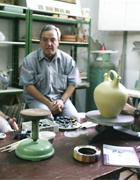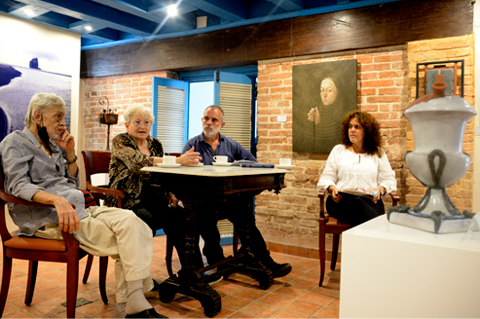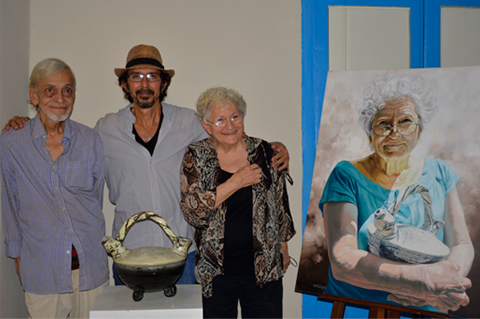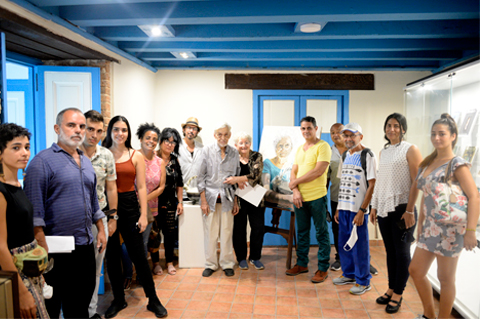For many years, the ceramists Amelia Carballo and Ángel Norniella, founders of Taller Terracota 4, helped to foster the personal collection of porrones belonging to Eusebio Leal Spengler. The City Historian spoke about the unconditional help of these artists in the interview granted to Argel Calcines, entitled “A day in the life of Eusebio Leal Spengler,” which was published by the City Historian in his book Legacy and Memory (2007). Here is a fragment of said interview reproduced on the occasion of the donation of the Porrón-cup piece that Amelia and Ángel made to the Permanent Gallery of the Opus Habana magazine on World Ceramist Day.
Argel Calcines: One of the main examples of your acute artistic sensitivity is your understanding of the visual arts, which you have actually cultivated personally, such as drawing and painting. Who are your favorite Cuban painters? Tell us about the origin of your collection of jugs illustrated by painters of all generations.
Eusebio Leal Spengler: While still a teenager, I went to the Academy of San Alejandro, but for the reasons already outlined in this sort of biography that we have made in flight, I could not stay there. So I went to the house of the painter Enrique Crucet so that he could give me and other young people classes on the preparation of canvases, drawing...
Crucet had been a disciple of Sorolla; he had met Picasso and worked in Cecilio Pla's studio in Spain... Although he was an academic painter, he had a very noble inspiration that made him different from that pure academicism that was already failing and exhausted. I still have some drawings, some things that I did at that time: charcoals, notes... but, in that direction, my pictorial vocation - let's say - went astray.
Later, when I began my working life, I had the opportunity to meet many artists, not only painters, but also personalities from the world of cinema, theatre, music, dance, literature... And when I had the first opportunity, I began to attend the cultural activities promoted by the University Extension. I was a regular at the recently founded Cinemateca in the Rialto cinemas, the current Chaplin and La Rampa; I especially loved the latter. Then I met Harold Gramatges, María Teresa Linares, Argeliers León, María Antonieta Henríquez, Hilario González... to name the musicians. And, at the same time, several well-known figures of Cuban art: Víctor Manuel García —for example—, who lived for some time in this very house where you and I are now.* But I met him in the Plaza de la Catedral, on the upper floors of the recently opened El Patio restaurant.
Then, when the Casa de las Américas opened to me, I met Mariano [Rodríguez], René Portocarrero, [Raúl] Milián... the writers Manuel Galich and Roberto Fernández Retamar, among other personalities linked to that institution of such importance for our culture, as we have already pointed out. I attended their concerts and exhibitions; hence my meeting with Leo Brouwer, Isaac and Noel Nicola, Pablo Milanés, Silvio Rodríguez... and, of course, Alfredo Guevara, who was like a mentor to me, like a reference model to guide me in the intellectual and artistic world.
I emphasize this background to emphasize the idea that, imbued by these contacts with the art world, my spirit needed a space to channel what you have called "acute artistic sensitivity." If so, this acuity would be expressed - above all - in my passion for collecting. I cannot speak to you of just one collection, but of many: stamps, tobacco labels, sculptures, old canvases, religious images... In the case of the latter, set aside on the occasion of the great liturgical reforms, they were given to me by priest friends who did not hesitate to give me or present me with that piece that now seemed obsolete and that for me was like a link between the past, the present and the future.
The fact is that I met many elderly people at the time when an old society in Cuba was declining. With their help I was able to elevate this collection to a great public task such as the creation of the City Museum in the former Palace of the Captains General, together with the expansion of the heritage collection that it houses today.
On the other hand, my eternal cult of Archaeology made me look for exponents that I later used in my own conferences during the trips I made to the interior of the country, bringing everything that could be useful to explain. I was always struck, when I went to the mobilizations during the harvest, by an object that for me was the constant of Spanish popular crafts or pottery. Along with the tobacco fields or the sugarcane fields, that object remained omnipresent in Cuban life. The so-called "porrón" (a kind of jug) by us. In Spain, today this type of vessel is proliferated for tourists. But the native botijo is seen less, the famous reaper's botijo, which was the one taken to the fields by those who cut wheat and other crops.
Thanks to Professor Rodríguez de la Cruz, who had a workshop in Santiago de las Vegas, I learned that painted porrones had been made there. And so I tried to collect the impossible: a porrón by Amelia Peláez —who, by the way, I never met personally—, a porrón by Portocarrero, a porrón by Mariano... The most amazing thing is that —in the end— I succeeded, and then I decided that it would be very nice if all my artist friends could make exclusive pieces, decorated especially for me. In this way, many painters who had never made ceramics dared to venture into the genre, with the unconditional help of Amelia Carballo and Ángel Norniella in the Terracota 4 workshop. And one day I saw a group of great friends, gathered together, each one enthusiastically making their porrón.
It would be impossible to name all those who have left their mark on this collection because they number close to a hundred, belonging to various generational groups. Let's say there is the generation of Zaida del Río, Roberto Fabelo, Nelson Domínguez, Pedro Pablo Oliva, Ernesto García Peña, Choco... to which are added more recent generations, difficult to define in an epochal way, such as Cosme Proenza, Sandra Ramos, Agustín Bejarano, Ernesto Rancaño, Carlos Guzmán, Vicente Hernández...
There are also pieces by artists residing outside of Cuba, such as Tomás Sánchez, José Bedia, Moisés Finalé... In short, it is a beautiful collection that has given me much satisfaction and no small amount of joy.
*Refers to the Lombillo Palace, where Leal lived from 2001 to 2007 and where the headquarters and permanent gallery of the Opus Habana magazine are located today .
[Chamrosh.co] Sell Smtp large sending limit - Smtp Inbox All Domain - Webmail Inbox All - Rackspace Webmail - Bulletproof cpanels - Spam Tools Spoof Sender Emails & Bomber Emails
Office website: https://chamrosh.co/
Telegram channel: https://t.me/chamroshcyber
Telegram: channel: https://t.me/chamroshpwns
 |
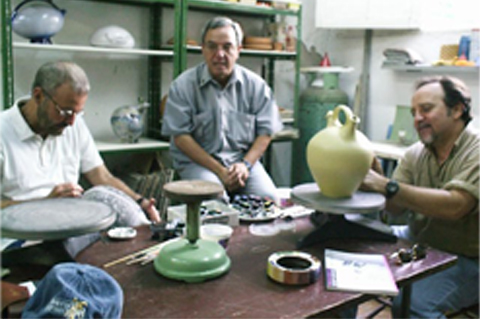 |
| Above: Eusebio Leal Spengler observes the decoration of a porrón by artist Miguel Ángel González. Below: With Tomás Sánchez and Roberto Fabelo at the Terracota 4 Workshop. |
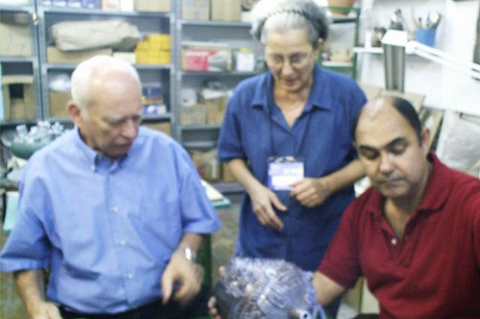 |
 |
| Above: with Alfredo Sosabravo. Below, with Eduardo Roca (Choco). |
 |
Amelia Carballo and landscaper Ania Toledo. |
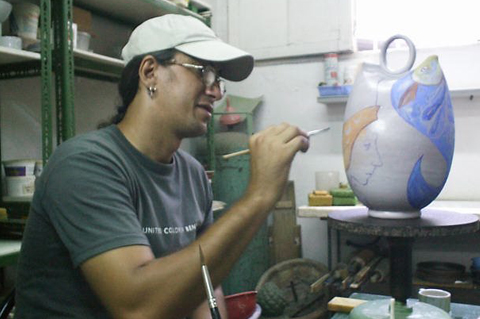 |
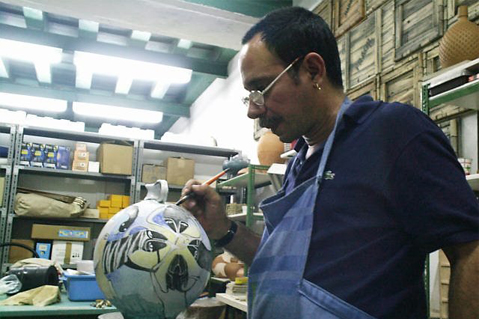 |
| Carlos Guzman (top) and Juan Vicente Rodriguez Bonachea (bottom). |
Opus Habana Editorial





